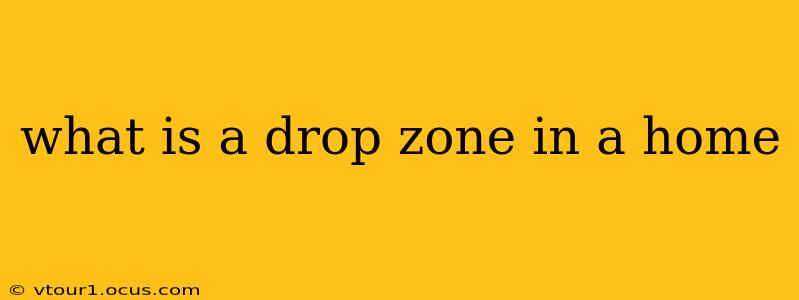A drop zone in a home is a designated area, typically near the entryway, designed to corral incoming items and prevent clutter from spreading throughout the house. Think of it as a controlled chaos zone—a place where keys, mail, bags, shoes, and other everyday items can be temporarily deposited before they find their proper homes. It's a highly functional space that helps maintain a more organized and streamlined living environment. Unlike a mudroom, which often implies more extensive storage and space, a drop zone can be as simple or elaborate as you need it to be.
What are the benefits of having a drop zone?
The benefits of a designated drop zone are numerous, especially for busy families:
- Reduced Clutter: The most significant benefit is the reduction of clutter. Instead of items being strewn across counters, tables, and floors, they have a dedicated place.
- Improved Organization: A drop zone establishes a system for incoming items, making it easier to manage mail, keys, and other essentials.
- Increased Efficiency: Knowing where to put things saves time and reduces the frustration of searching for lost items.
- Enhanced Curb Appeal (indirectly): A well-organized entryway creates a more welcoming and less stressful atmosphere for you and your guests. An uncluttered entryway also contributes to a better first impression.
What features are typically included in a drop zone?
A drop zone can range in complexity, but common features include:
- Shelving: Open shelves are ideal for mail, keys, and frequently used items.
- Hooks: Hooks provide a place for coats, bags, and backpacks.
- Drawers: Drawers offer concealed storage for smaller items.
- Cubbies: Cubbies are perfect for shoes and other items that need to be separated.
- Bench or Seating: A small bench or seating area is useful for putting on and taking off shoes.
- Built-in Storage: Larger homes may incorporate built-in cabinets or a dedicated closet for extra storage.
How much space do I need for a drop zone?
The size of your drop zone depends entirely on your needs and available space. A small corner with a few hooks and a shelf can be sufficient, while a larger family might benefit from a more extensive setup. Even a few feet of wall space can be effectively utilized. Consider the number of people in your household and the volume of items that typically come in and out daily.
Where should I locate my drop zone?
The optimal location for a drop zone is typically near the main entryway, making it convenient for depositing items as soon as you enter the house. However, the specific location depends on your home's layout and your personal preferences. A hallway closet, a section of wall near the front door, or even a repurposed corner can all work well.
What are some creative drop zone ideas?
There's no need for a drop zone to look utilitarian. Get creative! Consider:
- Using repurposed furniture: An old dresser or console table can be easily converted into a drop zone.
- Installing stylish hooks and shelves: Choose hooks and shelves that complement your home's decor.
- Adding a decorative basket or bin: A stylish basket can help contain smaller items.
- Incorporating a mirror: A mirror near the drop zone can be both functional and decorative.
Can I create a drop zone on a budget?
Absolutely! A budget-friendly drop zone can be achieved by using readily available items such as inexpensive shelves, hooks, and baskets. Repurposing existing furniture is another great way to create a functional drop zone without breaking the bank. Focus on functionality first, then add decorative elements later.
By carefully planning and implementing a well-designed drop zone, you can significantly improve your home's organization and create a more welcoming and efficient entryway. Remember to prioritize practicality and customize your drop zone to fit your specific needs and lifestyle.
